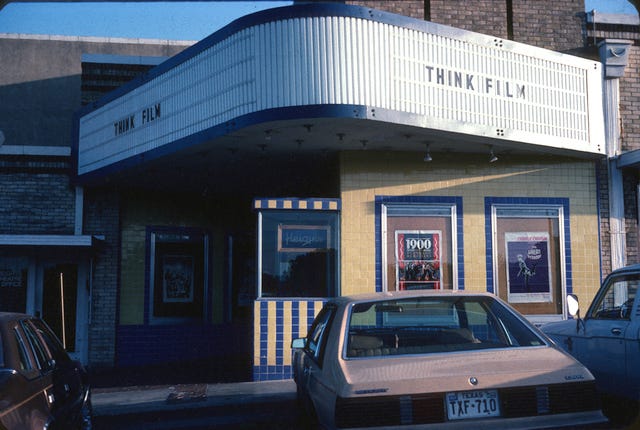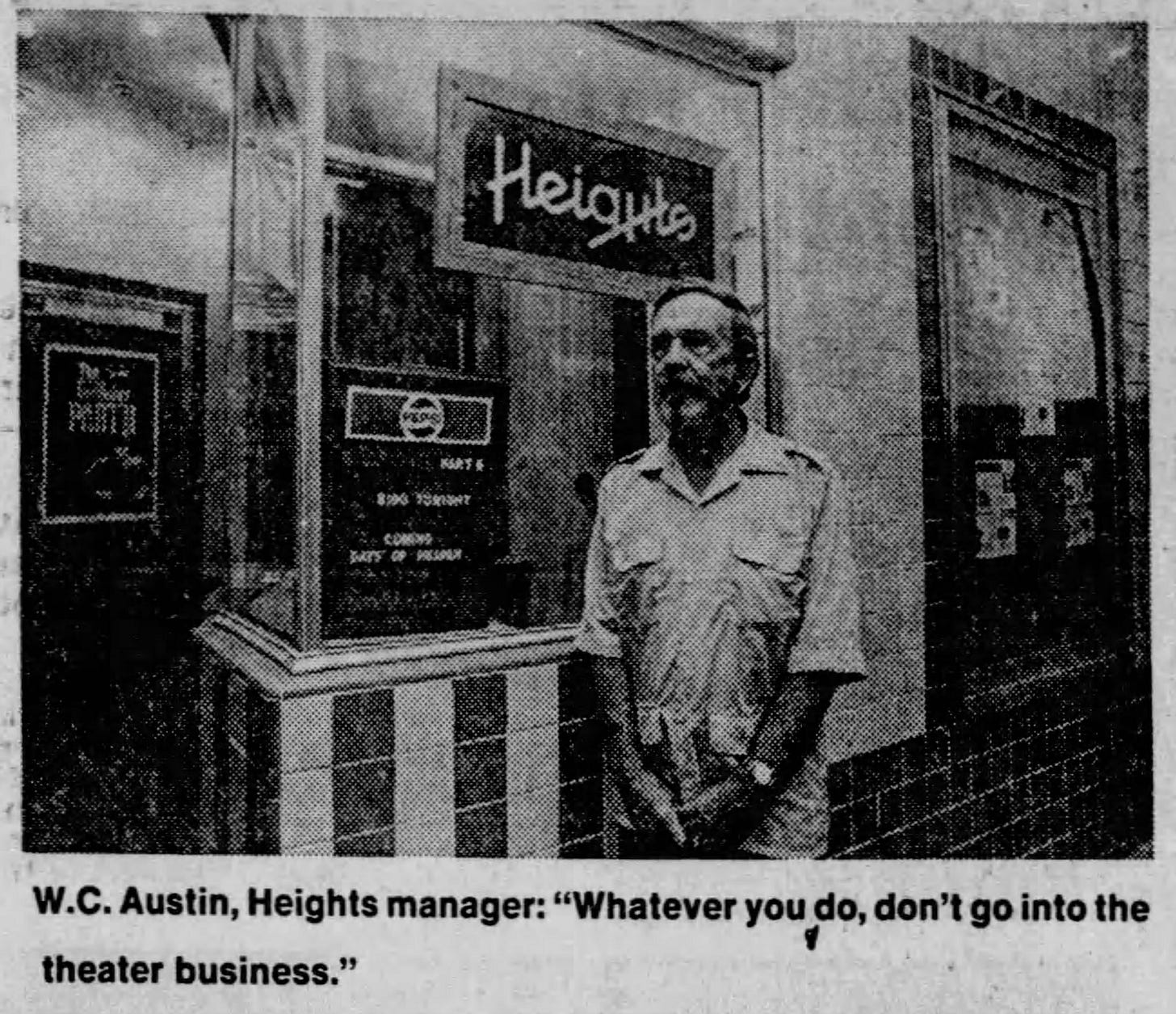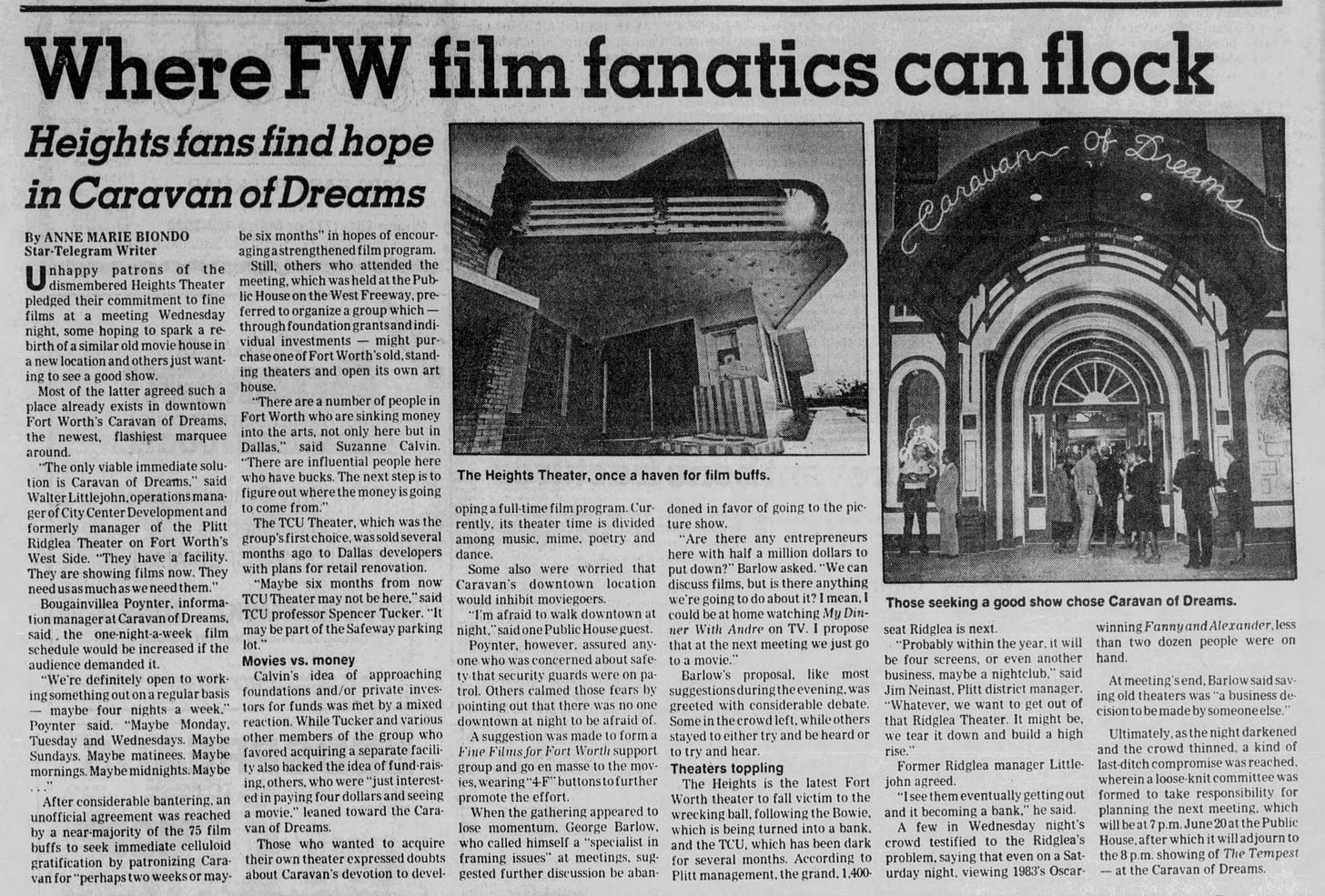The rise and fall of the Fort Worth Film Fiends
Plus some thoughts about the state of this newsletter.
Hello and thanks for reading.
Before we get to today’s actual post, which is a sequel to my thing about Fort Worth’s first art house theater, I have some housekeeping notes.
I’ve gotten a few new subscribers recently (thank you for signing up, please tell your friends). But I only just realized the initial welcome note y’all received in your inboxes was hopelessly out-of-date. I believe the last time I actually updated it was in like March 2023. So to set the record straight: I’m no longer posting on Sundays, as that initial email says; instead, I’m publishing new material on Wednesdays and Saturdays.
Longtime Lost in Panther City subscribers have probably also noticed that I’ve moved away from just posting about Fort Worth history. I originally saw this project as a way to explore lesser-known historical stories that aren’t just an endless recitation of the same-old “Where the West Begins” mythos. But I eventually realized I actually have a lot of opinions about present-day things like Mercy Culture’s upcoming helicopter hog hunt fundraiser. (No one who knows me personally will be at all surprised by this.)
Spaces for publishing thoughtful or interesting local commentary are extremely scarce. Realistically, no media outlet was going to pay me to write about how disorienting the Stock Show and Rodeo is to me personally in the year of our lord 2024. Still I felt compelled write it and several people told me they liked that post so maybe it was actually good. I dunno it can be hard to tell from here in my little writing cave.
That’s a long way of saying that I’m hoping to make this a venue for writing about Fort Worth and North Texas that might not find a home anywhere else, whether it’s strictly historical or not. So thanks for being here and continuing to read my work.
One last thing: This newsletter has an Instagram account now! Go follow @lostinpanthercity.
The rise and fall of the Fort Worth Film Fiends

It’s always bad when a movie theater closes. But it’s far worse when a movie theater shuts down and then is physically obliterated by a freeway expansion, foreclosing the possibility that the space could ever be resurrected or reused.
This second scenario describes the unhappy fate of the Heights Theater in Fort Worth.
The Heights originally opened in 1947 and, as I described in a post last month, survived numerous transformations over the years. It became a porn venue, a Spanish-language moviehouse, an art house theater called The Borzoi, and finally, in 1978, it reclaimed the original Heights name.
In some ways, the new Heights continued the legacy of the Borzoi. Newspaper accounts describe its programming as a combination of classic reruns and foreign films and portray its owner, W. C. Austin, as a committed cinephile. This excerpt from a 1981 Star-Telegram story is typical:
“When we came into this, it was the kind of thing where we saw the opportunity to do something with film,” says Austin. “We also saw the opportunity to do something with the theater itself because the theater, the physical side of it, is very important. We cared. We cared about people and about quality. And caring is awfully important.”
That’s a point Austin emphasizes more than once. It’s whay [sic] he talks about showcasing a film once a night rather that [sic] grinding pictures out one show after another. It’s why he talks about the entire move-going experience as a performance. It’s why he say’s [sic] he’s not in competition with other theaters, why he’d rather sell fruit juices than soft drinks at his concession stand, why he says he doesn’t care that his concession stand isn’t profitable because he’s in the film business, not the concession business, and would rather see an audience enjoying a film so much the people won’t come outside to the concession stand during a showing.
But in the early-1980s, this “utopia for film connoisseurs,” as the newspaper described it, was razed along with dozens of other business by the expansion of I-30. It was such an ugly and totally unsurprising urban planning decision. Annihilate a worthwhile community resource so we can funnel thousands more cars per day through the heart of the metroplex? Hell yes, said the city. And thus we moved one step closer to the platonic ideal of DFW in which every neighborhood has been paved over and replaced with a 60,000 lane highway in a permanent state of gridlock: Concrete utopia.
The whole block where the Heights stood, which used to be part of West Rosedale, just doesn’t exist anymore. It’s gone. The theater’s former address is like a ghost now.
But this post isn’t really about the destruction of the Heights. It’s about what that destruction caused.
In 2022, the closing of the Grand Berry prompted the formation of the Fort Worth Film Club.
Four decades earlier, in 1984, the closing of the Heights catalyzed the birth of the Fort Worth Film Fiends.
Who were the Fort Worth Film Fiends? That’s a great question and perhaps one that even the group itself wasn’t able to answer. I say this because newspaper stories from 1984, the only year in which the group seems to have been active, refer to it by four different names:
Fort Worth Film Fiends
Film Fiends Fort Worth
Fine Films for Fort Worth
Fine Film Fiends of Fort Worth
This inchoate array of names speaks, I think, to the nature of the organization, a term that seems applicable only in the loosest sense. When the Heights shuttered, a group of frustrated film, uh, fiends began holding meetings to figure out what exactly could be done to replace the only venue that consistently showed films with artistic value. The Star-Telegram announced their first meeting in May 1984:
A group of fine film fans will meet Wednesday at 8 p.m. in the Public House, 1115 West Freeway (near Ballinger Street), with the goal of obtaining an art movie house for Fort Worth.
“It was such a tragedy to lose the Heights,” said Texas Christian University professor Spencer Tucker, referring to the fine film theater which was forced to close last year by the expansion of Interstate 30. “It seems a shame that with Fort Worth’s commitment to the arts, we don’t have anything like that now. We’re not talking about something that would be off-beat. We’re talking about older films, art films and those that might play to a smaller audience.
“We feel there’s a large number of people in Fort Worth interested in these films,” said Tucker, one of the people responsible for the new Fort Wort [sic] group’s gathering. “We need to find out who they are, and we encourage anyone really interested to come to the meeting on Wednesday night.”
From the beginning the group seemed split on how precisely to fill the cultural vacuum created by the loss of the Heights. There was talk of screening films in the Caravan of Dreams, the now-defunct performing arts space conceived and funded by Ed Bass, which at the time was showing a single movie a week but was centered more around live music and theater than cinema. Members also floated the idea of trying to buy an old theater and transform it into an art house, an extremely ambitious proposal that would’ve required significant outside fundraising. (As one of the attendees at the first meeting put it: “Are there any entrepreneurs here with half a million dollars to put down?” Ed Bass was, it seems, not in attendance.)
The group convened several meetings, and the Star-Telegram dutifully chronicled them, but the divisions only seemed to deepen. As the newspaper reported in June 1984, George Barlow, the chairman of the group,
mailed meeting notices to 229 people who have been to previous meetings. Fifty came to the meeting. And less than 25 went to the Caravan of Dreams to see The Tempest afterward.
“Of the 229 who expressed an interest in seeing films, less than 10 percent went to the movie,” Barlow said. “I’m concluding that most people would rather go to a meeting and talk about having a movie theater.”
The group also disagreed over whether the Berry theater — yet another historic venue Fort Worth didn’t bother to save — might fit their goals. The theater was struggling to fill seats in 1984 and its owner, Basil Huckabee, reportedly took a hands-off approach to maintenance. (Translation: The building wasn’t well cared for.) But a local neighborhood association pitched the Film Fiends on the prospect of serving as a new, consistent audience and — the hope was — this would persuade Huckabee to invest in revitalizing his business. The idea went nowhere. (There’s an alternate history in which this plan succeeded and the Berry theater is still showing movies to this day. But of course we’re not lucky enough to live in that reality.)
Ultimately, the Film Fiends themselves seemingly didn’t last long beyond the summer — or at least, if they did last, I can’t find any record of them. In December, Mike Ritchey, the Star-Telegram’s film writer, reported: “The group has played itself out. There have been no meetings in the last several months and none is scheduled.”
The group receded from public view without accomplishing their goal of finding a community space for screening good movies. Ritchey noted, in his obituary for the Film Fiends, that interesting and eclectic films were hard to find in Fort Worth, and his description of making eastward pilgrimages for the sake of moviegoing feels eerily familiar:
Because this writer has the enviable job of seeing all sorts of films and writing about them, he drives to Dallas more than once or twice a week. Even then, many of the pictures he witnesses will never show in Fort Worth because there is no “art” house where they might play. The chains are not interested. Driving back to Fort Worth and writing about such films is not unlike a foreign correspondent’s covering a famine in Ethiopia and sending dispatches to be read by people back in the states who will never feel the hunger pains.
So why care about the Fort Worth Film Fiends, or whatever they officially called themselves? I see two ways to interpret their story, two potential morals one can wrench from this little historical fable.
The first is depressing: Fort Worth has never really had enough enthusiasm to support a group of film buffs in the long-term, and the city’s placid indifference to anything resembling an alternative culture has crushed and will continue to crush efforts like theirs.
The second is hopeful: The Fort Worth Film Fiends are in fact clear evidence that there’s always been a desire to create alternative cultural spaces in the city. Even if those efforts have been stymied or ill-conceived or poorly executed, their existence still matters. The people who wanted a space in Fort Worth to enjoy “fine films” may have been a seemingly inconsequential minority, but their brief doomed existence was at least an attempt to preserve a community apart from the suffocating monoculture of mainstream American society.
Ritchey, the Star-Telegram’s film columnist, remarked that when The Heights did program non-mainstream fare that the local chains wouldn’t touch, it was often astonishingly successful. La Cage aux Folles, the 1978 French film about a gay couple who operate a drag club — later adapted into the 1996 American film The Birdcage — reportedly set attendance records at the theater!
So despite my general cynicism about Fort Worth’s dedication to supporting arts and culture, I prefer to believe the second story. How about you?





